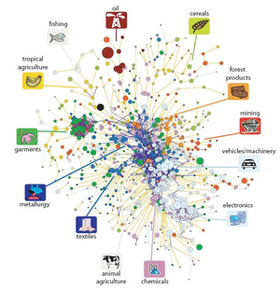August 29, 2007 feature
Nation's position in 'product space' determines economic growth

Researchers have constructed a network of the relatedness between products, providing insight into the economic question of why some countries can quickly climb the manufacturing ladder, while others fail to develop more sophisticated products.
In a recent issue of Science, physicists César Hidalgo and Laszlo Barabási from Notre Dame, along with economists Bailey Klinger and Ricardo Hausmann from Harvard University, have presented a network of what they coined as the “product space.” In the network, connections show the probabilities that a country exports a pair of products. Their results show how the types of products a nation produces and exports determines the probability of that nation developing more competitive products, thus influencing its overall economic wealth and growth.
“As a joke, I can say that this is what happens when a Venezuelan (Ricardo Hausmann) a Canadian (Bailey Klinger) a Hungarian/Rumanian (Laszlo Barabasi) and a Chilean (me) meet in Cambridge, Massachusetts,” Hidalgo told PhysOrg.com of the work’s motivating factors. “They redefine the way in which economic growth is understood.”
“In fact, this work was a multi-step process,” he continued. “Ricardo and Bailey had come up with the idea of a distance between products but were not clear of how to make sense of it at the global scale. That's were I came in and built the network, making the interpretation of a sophisticated concept more intuitive and visual.”
The researchers used trade data where all exports are coded within 775 product classes obtained from a National Bureau of Economic Research project. The structure of the product space is such that more sophisticated products (such as metal, machinery, and chemicals) formed the core, and had connections to many other products. A variety of other products (such as fishing, agriculture, textiles, electronics, and mining) comprised different clusters in the periphery of the product space.
The product space can be used to visualize the patterns defined by the exports of a particular country. As a rule of thumb, poor countries tend to occupy the periphery of the space while rich countries are preferentially located at the core of it. Since countries can move through the product space by developing goods similar to those they already produce, poorer countries have a more difficult time extending their product variety. But, in simplified terms, it’s easy for the rich to get richer.
While the model may sound intuitive, this research is the first time that countries’ different economic growth patterns have been explained by a product network. Past economic theories have relied on a country’s productive factors (labor, land, infrastructure, etc.) or technological capabilities, but have disregarded product similarities when explaining a country’s growth. In a sense, the product network incorporates these other factors under one model.
As part of a test of their model, the researchers asked if, given enough time, all countries could reach most of product space, particularly the richest parts. They found that the answer depends on the overall proximity of product space, as well as a country’s original positioning. For example, Chile and Korea have similar levels of production and export sophistication, but because Korea produces some core products, it can extend its sophisticated product line faster than Chile. The researchers even found that with countries that were developmentally similar, some were on a path to structural transformation while others seemed headed toward a dead end.
“What surprised me along the year and a half that this work took was the broad set of implications and questions that were opened,” Hidalgo said. “There are many hard science studies on complex systems where the application of the findings is not well defined. Here we have a well defined area of application (industrial policy), yet the study lends itself for research in similar data sets. We are working on other areas of applications, such as research and health policy.”
The researchers suggest that, for economic policy, estimating a country’s position in product space could have important consequences. For instance, countries in close proximity to other products could benefit the most from a relevant structural transformation, whereas countries at the periphery would need to make much longer jumps and would likely present a greater challenge to reform projects.
“The proximity between products in the space increases as more countries export them in tandem,” Hidalgo explained. “Thus the movement of countries deforms the space. The technique does not provide a general solution for policymaking, but a new method to analyze and tailor policies for individual countries."
Product space networks of many nations can be seen at www.nd.edu/~networks/productspace/country.htm .
Citation: Hidalgo, César, Klinger, Bailey, Barabási, Laszlo, and Hausmann, Ricardo. “The Product Space Conditions the Development of Nations.” Science, 27 July 2007, Vol. 317, 482-487.
Copyright 2007 PhysOrg.com.
All rights reserved. This material may not be published, broadcast, rewritten or redistributed in whole or part without the express written permission of PhysOrg.com.





















